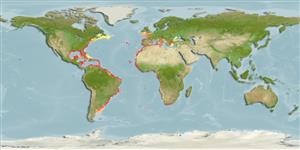Environment: milieu / climate zone / depth range / distribution range
Ecología
marino; salobre asociado a arrecife; rango de profundidad 1 - 100 m (Ref. 26999). Subtropical; 52°N - 45°S, 98°W - 36°E
Eastern Atlantic: English Channel to Angola, including the Mediterranean, Madeira, and the Azores. Western Atlantic: Canada (Ref. 5951) to Massachusetts, USA and the Gulf of Mexico to Argentina.
Length at first maturity / Tamaño / Peso / Age
Maturity: Lm 19.5 range ? - ? cm
Max length : 50.0 cm SL macho / no sexado; (Ref. 6544); common length : 38.0 cm TL macho / no sexado; (Ref. 3397); peso máximo publicado: 1.8 kg (Ref. 4699)
Espinas dorsales (total): 7; Radios blandos dorsales (total): 8; Espinas anales 0; Radios blandos anales: 6. Pectoral fin very large and fan-like, with front 6 rays separated as small lobe (Ref. 26938).
Found on sand, mud or over rocks in sandy areas, exploring the bottom with the free part of the pectoral fins (Ref. 6544). Feeds primarily on benthic crustaceans, especially crabs, clams and small fishes. Neither anterolateral glandural groove nor venom gland is present (Ref. 57406).
Life cycle and mating behavior
Madurez | Reproducción | Puesta | Huevos | Fecundidad | Larva
Eschmeyer, W.N. and L.J. Dempster, 1990. Dactylopteridae. p. 690-691. In J. C. Quero, J. C. Hureau, C. Karrer, A. Post, and L. Saldanha (eds.) Check-list of the fishes of the eastern tropical Atlantic (CLOFETA). JNICT, Lisbon; SEI, Paris; and UNESCO, Paris. Vol. 2. (Ref. 10782)
IUCN Red List Status (Ref. 130435)
Warning: mysqli::__construct(): (HY000/1040): Too many connections in /var/www/html/includes/func_getlabel.php on line 46
Can't connect to MySQL database (fbapp). Errorcode: Too many connections
